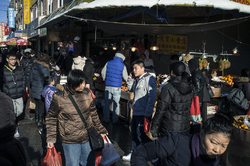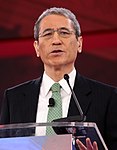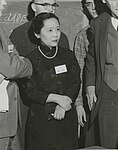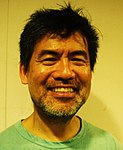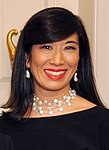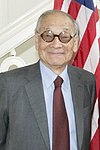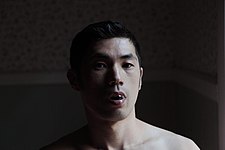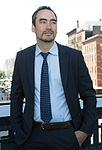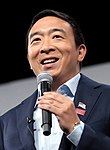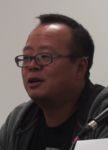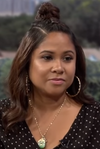Chinese people in the New York City metropolitan area
| Part of a series on |
| Race and ethnicity in New York City |
|---|
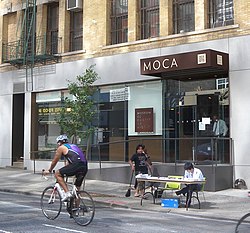
The New York metropolitan area is home to the largest and most prominent ethnic Chinese population outside of Asia, hosting Chinese populations representing all 34 provincial-level administrative units of China.[1][2] The Chinese American population of the New York City metropolitan area was an estimated 893,697 as of 2017, constituting the largest and most prominent metropolitan Asian national diaspora outside Asia.[3] New York City itself contains by far the highest ethnic Chinese population of any individual city outside Asia, estimated at 628,763 as of 2017.[4]
New York City and its surrounding metropolitan area, including Long Island and parts of New Jersey, is home to 12 Chinatowns, districts where Chinese immigrants were made to live for economic survival and physical safety[5] that are now known as important sites of tourism and urban economic activity. Six Chinatowns[6] (or nine,[7] New York including the emerging Chinatowns in Elmhurst and Whitestone, Queens,[8] and East Harlem, Manhattan) are located in New York City proper. Chinese communities are also located in more suburban areas such as Jersey City, New Jersey; Nassau County, Long Island; Edison, New Jersey;[8] West Windsor, New Jersey; and Parsippany-Troy Hills, New Jersey.
China City of America in Sullivan County, New York is proposed in 2012 but whose development has stalled due to the 2022 arrest of its CEO. Dragon Springs (in Deerpark, Orange County, New York) serves as the de facto headquarters for both the global Falun Gong New religious movement as well as its Shen Yun performance arts troupe.[9]
The Chinese American community in the New York metropolitan area is rising rapidly in population as well as economic and political influence. Continuing significant immigration from mainland China[10] has spurred the ongoing rise of the Chinese population in the New York metropolitan area; this immigration and its accompanying growth in the impact of the Chinese presence continue to be fueled by New York's status as an alpha global city, its high population density, its extensive mass transit system, and the New York metropolitan area's enormous economic marketplace. As of 2024, illegal Chinese immigration to New York City has accelerated,[11] including a significant new wave of Chinese Uyghur Muslims fleeing religious persecution in northwestern China's Xinjiang Province and seeking religious freedom in New York,[12] concentrating in Queens.
History
[edit]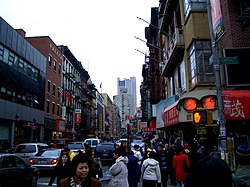
Among the earliest documented arrivals of Chinese immigrants in New York City were of "sailors and peddlers" in the 1830s. These arrivals were followed in 1847 by three students who came to continue their education in the United States. One of these scholars, Yung Wing, soon became the first Chinese American to graduate from a U.S. college in 1854, when Wing graduated from Yale University.
Many more Chinese immigrants arrived and settled in Lower Manhattan throughout the 1800s, including an 1870s wave of Chinese immigrants searching for "gold.[13]" By 1880, the enclave around Five Points was estimated to have from 200 to as many as 1,100 members.[13] However, the Chinese Exclusion Act, which went into effect in 1882, caused an abrupt decline in the number of Chinese who emigrated to New York and the rest of the United States.[13] Later, in 1943, the Chinese were given a small quota, the Immigration and Nationality Act of 1965 caused a revival in Chinese immigration,[14] and the community's population gradually increased until 1968, when the quota was lifted and the Chinese American population skyrocketed.[13]
In 1992, New York City officially began providing language assistance for electoral materials in Chinese, given that this population had reached a critical mass in numbers.[15] The Sino-American Friendship Association was established in Midtown Manhattan in 1992.[16] In 2022, "police service stations" serving as espionage arms of the Chinese Communist Party were discovered and shut down in Chinatown, Manhattan and Chinatown, Flushing.[17]
Demographics
[edit]New York City boroughs
[edit]
New York City has the largest Chinese population of any city outside of Asia[19] and within the U.S. with an estimated population of 573,388 in 2014,[20] and continues to be a primary destination for new Chinese immigrants.[21] New York City is subdivided into official municipal boroughs, which themselves are home to significant Chinese populations, with Brooklyn and Queens, adjacently located on Long Island, leading the fastest growth.[22][23] After the City of New York itself, the boroughs of Queens and Brooklyn encompass the largest Chinese populations, respectively, of all municipalities in the United States.
| Borough | Chinese Americans residents | |
|---|---|---|
| number | percent | |
| Queens[24] | 237,484 | 10.2 |
| Brooklyn[25] | 205,753 | 7.9 |
| Manhattan[26] | 107,609 | 6.6 |
| Staten Island[citation needed] | 13,620 | 2.9 |
| The Bronx[citation needed] | 6,891 | 0.5 |
| New York City[20] | 573,388 | 1,881.1 |
Large-scale immigration continues from China
[edit]In 2013, 19,645 Chinese legally immigrated to the New York-Northern New Jersey-Long Island, NY-NJ-PA core based statistical area from Mainland China, greater than the combined totals for Los Angeles and San Francisco, the next two largest Chinese American gateways;[27] in 2012, this number was 24,763;[28] 28,390 in 2011;[29] and 19,811 in 2010.[30] These numbers do not include the remainder of the New York-Newark-Bridgeport, NY-NJ-CT-PA Combined Statistical Area, nor do they include the significantly smaller numbers of legal immigrants from Taiwan and Hong Kong. There has additionally been a consequential component of Chinese emigration of illegal origin, most notably Fuzhou people from Fujian and Wenzhounese from Zhejiang in mainland China, specifically destined for New York City,[31] beginning in the 1980s.
Quantification of the magnitude of this modality of emigration is imprecise and varies over time, but it appears to continue unabated on a significant basis. As of April 2019, China Airlines (flying non-stop to Taipei), China Eastern Airlines, China Southern Airlines, EVA Air, Hainan Airlines, and XiamenAir all served John F. Kennedy International Airport (JFK), while Air China and Cathay Pacific Airways served both JFK and Newark Liberty International Airport in the New York metropolitan area – and among U.S. carriers, United Airlines flew non-stop from Newark to Beijing, Shanghai, and Hong Kong. Hainan Airlines flies non-stop from JFK to both Chengdu and Chongqing in Western China; while China Southern Airlines is expected to start non-stop flights from JFK to Wuhan, in Central China, in July 2019. Meanwhile, Singapore Airlines flies to Singapore, where Standard Chinese is one of the official state languages, both from Newark (with one of the longest non-stop flights in the world[32][33]) and from JFK.
Within the Chinese population, New York City is also home to between 150,000 and 200,000 Fuzhounese Americans, who have exerted a large influence upon the Chinese restaurant industry across the United States; the vast majority of the growing population of Fuzhounese Americans have settled in New York.
The Chinese immigrant population in New York City grew from 261,500 foreign-born individuals in 2000 to 350,000 in 2011, representing a more than 33% growth of that demographic.[34] Chinese immigrants represented 12,000 of the country's asylum requests in fiscal year 2013, of which 4,000 applied for asylum to the New York-area asylum office.
Movement within and outside the metropolitan area
[edit]As many immigrant Chinese to New York City move up the socioeconomic ladder, many have relocated to the suburbs for more living space as well as seeking particular school districts for their children. In this process, new Chinese enclaves and Chinatown commercial districts have emerged and are growing in these suburbs, particularly in Nassau County on Long Island and in some counties of New Jersey. Some Chinese New Yorkers are also migrating to Boston, Philadelphia,[35] and eastern Connecticut.[36][37][38]
Geography
[edit]
The Manhattan Chinatown was the original Chinatown.[39] Little Fuzhou in Manhattan is an ethnoculturally distinct neighborhood within the Manhattan Chinatown itself, populated primarily by Fujianese people. The Sunset Park neighborhood of Brooklyn houses another such Little Fuzhou. Queens and Brooklyn are home to other Chinatowns. The Flushing as well as Elmhurst areas of Queens, Bensonhurst and Homecrest, neighborhoods in Brooklyn[40] also have spawned the development of numerous other Chinatowns. Most of Manhattan, as well as Corona in Queens, the Brooklyn Heights and Park Slope areas of Brooklyn, and northeast Staten Island, have also received significant Chinese settlement.[39][41]
Chinatowns
[edit]Manhattan (曼哈頓華埠)
[edit]Manhattan's Chinatown holds the highest concentration of Chinese people in the Western Hemisphere.[42][43] Manhattan's Chinatown is also one of the oldest Chinese ethnic enclaves.[44] The Manhattan Chinatown is one of nine Chinatown neighborhoods in New York City,[7] as well as one of twelve in the New York metropolitan area, which contains the largest ethnic Chinese population outside of Asia, comprising an estimated 893,697 uniracial individuals as of 2017.[45] Manhattan's Chinatown is actually divided into two different portions. The western portion is the older and original part of Manhattan's Chinatown, primarily dominated by Cantonese populations and known colloquially as the Cantonese Chinatown. Cantonese were the earlier settlers of Manhattan's Chinatown, originating mostly from Hong Kong and from Taishan in Guangdong Province, as well as from Shanghai.[46] They form most of the Chinese population of the area surrounded by Mott and Canal Streets.[46]
However, within Manhattan's Chinatown lies Little Fuzhou or The Fuzhou Chinatown on East Broadway and surrounding streets, occupied predominantly by immigrants from the province of Fujian in mainland China. They are the later settlers, from Fuzhou, Fujian, forming the majority of the Chinese population in the vicinity of East Broadway.[46] This eastern portion of Manhattan's Chinatown developed much later, primarily after the Fuzhou immigrants began moving in.
Areas surrounding "Little Fuzhou" consist of significant numbers of Cantonese immigrants from the Guangdong of China; however, the main concentration of people speaking the Cantonese language is in the older western portion of Manhattan's Chinatown. Despite the fact that the Mandarin speaking communities were becoming established in Flushing and Elmhurst areas of Queens during the 1980s–1990s and even though the Fuzhou immigrants spoke Mandarin often as well, however, due to their socioeconomic status, they could not afford the housing prices in Mandarin speaking enclaves in Queens, which were more middle class and the job opportunities were limited. They instead chose to settle in Manhattan's Chinatown for affordable housing and as well as the job opportunities that were available such as the seamstress factories and restaurants, despite the traditional Cantonese dominance until the 1990s. Eventually this pattern was repeated in Brooklyn's Sunset Park Chinatown, but on a much more immense scale.
The Cantonese dialect that has dominated Chinatown for decades is being rapidly swept aside by Mandarin, the national language of China, which is becoming the lingua franca. This can be attributed to the influx of immigrants from Fuzhou who often speak Mandarin, as well as the increase in Mandarin-speaking visitors coming to visit the neighborhood.[47]
The modern borders of Manhattan's Chinatown are roughly Delancey Street on the north, Chambers Street on the south, East Broadway on the east, and Broadway on the west.[48]
Queens (皇后華埠)
[edit]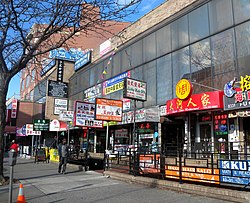
New York City's satellite Chinatowns in Queens, as well as in Brooklyn, are thriving as traditionally urban enclaves, as large-scale Chinese immigration into New York continues,[51][52][53][54] with the largest metropolitan Chinese population outside Asia.[55] busy intersection of Main Street, Kissena Boulevard, and 41st Avenue in the Flushing Chinatown (法拉盛華埠), in Queens. The segment of Main Street between Kissena Boulevard and Roosevelt Avenue, punctuated by the Long Island Rail Road trestle overpass, represents the cultural heart of Flushing Chinatown. Housing more than 30,000 individuals born in China alone, the largest by this metric outside Asia, Flushing is home to one of the largest and fastest-growing Chinatowns in the world.[49] Massage parlors in the Flushing Chinatown have become the hub of organized prostitution in the United States.[56]
The Flushing Chinatown, in the Flushing area of the borough of Queens in New York City, is one of the largest and fastest growing ethnic Chinese enclaves outside Asia, as well as within New York City itself. Main Street and the area to its west, particularly along Roosevelt Avenue, have become the primary nexus of Flushing Chinatown. However, Flushing Chinatown continues to expand southeastward along Kissena Boulevard and northward beyond Northern Boulevard. In the 1970s, a Chinese community established a foothold in the neighborhood of Flushing, whose demographic constituency had been predominantly non-Hispanic white. Taiwanese began the surge of immigration. It originally started off as Little Taipei or Little Taiwan due to the large Taiwanese population. Due to the then dominance of working class Cantonese immigrants of Manhattan's Chinatown including its poor housing conditions, they could not relate to them and settled in Flushing.
Later on, when other groups of Non-Cantonese Chinese, mostly speaking Mandarin started arriving into NYC, like the Taiwanese, they could not relate to Manhattan's then dominant Cantonese Chinatown, as a result they mainly settled with Taiwanese to be around Mandarin speakers. Later, Flushing's Chinatown would become the main center of different Chinese regional groups and cultures in NYC. By 1990, Asians constituted 41% of the population of the core area of Flushing, with Chinese in turn representing 41% of the Asian population.[57] However, ethnic Chinese are constituting an increasingly dominant proportion of the Asian population as well as of the overall population in Flushing and its Chinatown. A 1986 estimate by the Flushing Chinese Business Association approximated 60,000 Chinese in Flushing alone.[58] Mandarin Chinese[59] (including Northeastern Mandarin), Fuzhou dialect, Min Nan Fujianese, Wu Chinese, Beijing dialect, Wenzhounese, Shanghainese, Suzhou dialect, Hangzhou dialect, Changzhou dialect, Cantonese, Hokkien, and English are all prevalently spoken in Flushing Chinatown, while the Mongolian language is now emerging. Even the relatively obscure Dongbei style of cuisine indigenous to Northeast China is now available there.[60] Given its rapidly growing status, the Flushing Chinatown has surpassed the original New York City Chinatown in the Borough of Manhattan in size and population, while Queens and Brooklyn vie for the largest Chinese population of any municipality in the United States other than New York City as a whole.
Elmhurst, another neighborhood in Queens, also has a large and growing Chinese community.[61] Previously a small area with Chinese shops on Broadway between 81st Street and Cornish Avenue, this new Chinatown has now expanded to 45th Avenue and Whitney Avenue. Since 2000, thousands of Chinese Americans have migrated into Whitestone, Queens (白石), given the sizeable presence of the neighboring Flushing Chinatown, and have continued their expansion eastward in Queens and into neighboring, highly educated Nassau County (拿騷縣) on Long Island (長島), which has become the most popular suburban destination in the U.S. for Chinese.[62][63][64]
Brooklyn (布魯克林華埠)
[edit]By 1988, 90% of the storefronts on Eighth Avenue in Sunset Park, Brooklyn, were abandoned. Chinese immigrants then moved into this area, consisting of not only new arrivals from China, but also members of Manhattan's Chinatown seeking refuge from high rents, who flocked to the relatively less expensive property costs and rents of Sunset Park and formed the original Brooklyn Chinatown,[69] which now extends for 20 blocks along 8th Avenue, from 42nd to 62nd Streets. This relatively new but rapidly growing Chinatown located in Sunset Park was originally settled by Cantonese immigrants like Manhattan's Chinatown in the past. However, in the recent decade, an influx of Fuzhou immigrants has been pouring into Brooklyn's Chinatown and supplanting the Cantonese at a significantly higher rate than in Manhattan's Chinatown, and Brooklyn's Chinatown is now home to mostly Fuzhou immigrants.
In the past, during the 1980s and 1990s, the majority of newly arriving Fuzhou immigrants settled within Manhattan's Chinatown, and the first Little Fuzhou community emerged within Manhattan's Chinatown; by the first decade of the 21st century, however, the epicenter of the massive Fuzhou influx had shifted to Brooklyn's Chinatown, which is now home to the fastest-growing and perhaps largest Fuzhou population in New York City. Unlike the Little Fuzhou in Manhattan's Chinatown, which remains surrounded by areas which continue to house significant populations of Cantonese, all of Brooklyn's Chinatown is swiftly consolidating into New York City's new Little Fuzhou. However, a growing community of Wenzhounese immigrants from China's Zhejiang is now also arriving in Brooklyn's Chinatown.[70][71] Also in contrast to Manhattan's Chinatown, which still successfully continues to carry a large Cantonese population and retain the large Cantonese community established decades ago in its western section, where Cantonese residents have a communal venue to shop, work, and socialize, Brooklyn's Chinatown has seen a change from its primarily Cantonese community identity to a more diverse Chinese melange.[72]
Like Manhattan's Chinatown during the 1980s and 1990s (pre-gentrification), Brooklyn's Chinatown became the main affordable housing center for Fuzhou immigrants – and for job opportunities ranging from seamstress factories and restaurants – despite its domination by Cantonese immigrants in the earlier years.
Bensonhurst, Brooklyn, as well as Avenue U in Homecrest, Brooklyn, in addition to Bay Ridge, Borough Park, Coney Island, Dyker Heights, Gravesend, and Marine Park, have given rise to the development of Brooklyn's newer satellite Chinatowns, as evidenced by the growing number of Chinese-run fruit markets, restaurants, beauty and nail salons, small offices, and computer and consumer electronics dealers. While the foreign-born Chinese population in New York City jumped 35 percent between 2000 and 2013, to 353,000 from about 262,000, the foreign-born Chinese population in Brooklyn increased 49 percent during the same period, to 128,000 from 86,000, according to The New York Times. The emergence of multiple Chinatowns in Brooklyn is due to the overcrowding and high property values in Brooklyn's main Chinatown in Sunset Park, and many Cantonese immigrants have moved out of Sunset Park into these new areas. As a result, the newer emerging, but smaller Brooklyn's Chinatowns are primarily Cantonese dominated while the main Brooklyn Chinatown is increasingly dominated by Fuzhou emigres.[40][73]
List
[edit]- Chinatowns of NYC:
Long Island
[edit]Long Island comprises Brooklyn, Queens, as well as Nassau and Suffolk counties. Heavy Chinese migration is occurring from Brooklyn and Queens eastward, most notably settling into suburban Nassau County, often in search of numerous public schools considered among the topmost in the U.S.
New Jersey
[edit]Bergen County, Middlesex County, Mercer County, Morris County, and Somerset County all are home to significant Chinese communities. Substantial Chinese American communities can also be found throughout many individual suburban municipalities in New Jersey, most notably in Parsippany-Troy Hills, West Windsor, and Edison. Heavy Chinese migration is also occurring to central Jersey (as well as to neighboring Bucks County, Pennsylvania) specifically seeking proximity to the top-ranked Princeton University. Numerous Chinese commercial establishments, including restaurants and supermarkets, serve these communities.
Culture
[edit]
Languages
[edit]For much of the overall history of the Chinese community in New York City, Taishanese was the dominant Chinese variety.[74] After 1965, an influx of immigrants from Hong Kong made Cantonese the dominant dialect for the next three decades.
Later on, during the 1970s–80s, Mandarin and Fuzhou-speaking immigrants began to arrive into New York City. Taiwanese were settling into Flushing, Queens when it was still predominantly European American, while Fuzhou immigrants were settling in Manhattan's then very Cantonese-dominated Chinatown. The Taiwanese and Fuzhou people were the earliest significant numbers of Chinese immigrants to arrive into New York who spoke Mandarin but not Cantonese, although many spoke their regional Chinese dialects as well.
Since the mid-1990s, an influx of immigrants from various parts of mainland China has resulted in the increased influence of Mandarin in the Chinese-speaking world, with Chinese parents often having their children learn it regardless of their own linguistic background, and Mandarin has been in the process of becoming the dominant lingua franca among the Chinese population of New York City. In the Manhattan Chinatown, many newer immigrants who speak Mandarin live around East Broadway, while Chinatowns in Brooklyn and Queens have also witnessed influxes of Mandarin-speaking Chinese immigrants, as well as Min Chinese and Southern Min speakers.[74]
Unique demographics of New York City Chinese enclaves
[edit]This section may require cleanup to meet Wikipedia's quality standards. The specific problem is: copywriting. (June 2024) |
The different Chinese cultural and language groups as well as socioeconomic statuses are often subdivided among different boroughs of New York City. In Queens, the Chinatowns are very diverse, composed of different Chinese regional groups mainly speaking Mandarin although speaking other dialects as well, and who are more often middle- or upper-middle class. As a result, the Mandarin dialect is primarily concentrated in Queens. In addition, Flushing's Chinatown is now the largest Chinese cultural center of New York City, including being the most diverse with many different Chinese populations from many various regions of China and Taiwan, but in since the 2000s, especially since the 2010s, the Northeastern Chinese immigrants have been increasingly becoming a more dominant Chinese population in Flushing, Queens.
However, since Manhattan's Chinatown and Brooklyn's Chinese enclaves still hold large Cantonese speaking populations, who were the earlier Chinese immigrants to arrive into New York City and with the popularity of Hong Kong Cantonese cuisine and entertainment being widely available, the Cantonese dialect and culture still hold a large influence, and Cantonese is still a dialect in those enclaves.
Even though there are very large Fuzhou populations in Manhattan's Chinatown and Brooklyn's Chinese enclaves, many of whom speak Mandarin as well, Mandarin serves as only one of the dialects used in those enclaves in addition to Cantonese, rather than being the dominant one. In contrast, Mandarin serves as the predominant dialect in Queens, alongside various Chinese regional languages in Queens.
In Brooklyn, Fuzhou speakers predominate in the large Chinatown in Sunset Park, while the several smaller emerging Chinatowns in various sections of Bensonhurst and in a section of Sheepshead Bay contain primarily Cantonese speakers, unlike in Manhattan's Chinatown, where the Cantonese enclave and Fuzhou enclave are directly adjacent to each other. Therefore, usage of Mandarin and Cantonese dialects significantly varies between the different Chinatowns of Sunset Park, Bensonhurst and Sheepshead Bay. Cantonese is the main variety of Chinese spoken in Bensonhurst's and Sheepshead Bay's Chinatowns, since they are mostly Cantonese-populated; Mandarin is another, but less dominant variety. Since Sunset Park's Chinatown is now mostly Fuzhou populated, Mandarin is more dominant there. In Manhattan's Chinatown, Cantonese is dominant in the western portion and Fuzhounese in the eastern portion. Cantonese and Mandarin are equally spoken there due to the high number of mainland Chinese visitors and Cantonese residents from other neighborhoods.[75][76][77][78][79][80]
The Cantonese and Fuzhou populations are often more working class. However, because of the gentrification in Manhattan's Chinatown, Sunset Park in Brooklyn is increasingly becoming the main target for newly arrived Fuzhou immigrants while Bensonhurst and Sheepshead Bay in Brooklyn are increasingly becoming the main targets for the newly arrived Cantonese immigrants. This shift has now resulted in Brooklyn's Chinatowns rapidly replacing Manhattan's Chinatown as the largest primary gathering cultural centers for the Cantonese and Fuzhou populations of New York City.[81][82][83]

Cuisine
[edit]Given that the New York City metropolitan area has become home to the largest overseas Chinese population outside of Asia,[1][84] all popular styles of regional Chinese cuisine have commensurately become ubiquitously accessible in New York City,[85] including Hakka, Taiwanese, Shanghainese, Hunanese, Sichuanese, Cantonese, Fujianese, Xinjiang, Zhejiang, Korean-Chinese, and Malaysian Chinese cuisine. Even the relatively obscure Dongbei style of cuisine indigenous to Northeast China is now available in Flushing, Queens,[86] as well as Mongolian cuisine and Uyghur cuisine.[87] The availability of the regional variations of Chinese cuisine originating from throughout the different Provinces of China is most apparent in the city's Chinatowns in Queens, particularly the Flushing Chinatown (法拉盛華埠), but is also notable in the city's Chinatowns in Brooklyn and Manhattan.
Kosher preparation of Chinese food
[edit]Kosher preparation of Chinese food is also widely available in New York City, given the metropolitan area's large Jewish and particularly Orthodox Jewish populations. The perception that American Jews eat at Chinese restaurants on Christmas Day is documented in media as a common stereotype with a basis in fact.[88][89][90] The tradition may have arisen from the lack of other open restaurants on Christmas Day, as well as the close proximity of Jewish and Chinese immigrants to each other in New York City. Kosher Chinese food is usually prepared in New York City, as well as in other large cities with Orthodox Jewish neighborhoods, under strict rabbinical supervision as a prerequisite for Kosher certification.
News media
[edit]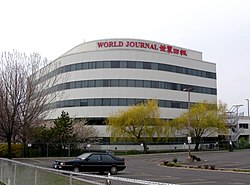
Numerous media publications geared toward serving the Chinese diaspora are headquartered in the New York metropolitan area. The World Journal, one of the largest Chinese-language newspapers outside of Asia, has its headquarters in Whitestone (白石), Queens.[91][92]
The China Press is headquartered in Midtown Manhattan.[93] The Epoch Times, an international multi-language newspaper and media company affiliated with the Falun Gong new religious movement, is also headquartered in Manhattan.[94][95][96][97] The Hong Kong-based, multinational Chinese-language newspaper Sing Tao Daily maintains its overseas headquarters in Chinatown, Manhattan. The Beijing-based, English-language newspaper China Daily publishes a U.S. edition, which is based in the 1500 Broadway skyscraper in Times Square.[98] In addition, both Sino Monthly and Global Chinese Times are published in Edison, Middlesex County, New Jersey,[99][100] to serve both a growing global readership and New Jersey's growing Chinese population of over 150,000 in 2016.[101]
Museums
[edit]The Museum of Chinese in America is located in the Manhattan Chinatown, at 215 Centre Street, and this prominent cultural institution has documented the Chinese American experience since 1980.
Chinese Lunar New Year
[edit]
Chinese Lunar New Year is celebrated annually throughout New York City's Chinatowns. Chinese New Year was signed into law as an allowable school holiday in the State of New York by Governor Andrew Cuomo in December 2014, as absentee rates had run as high as 60% in some New York City schools on this day.[102] In June 2015, New York City Mayor Bill de Blasio declared that the Lunar New Year would be made a public school holiday;[103] and in September 2023, New York State made Lunar New Year a mandatory public school holiday.[104]
Religion
[edit]This section needs expansion with:
|
Beginning in 2006 many Chinese Catholics began worshipping at St. John Vianney Church in Flushing.[105]
Education
[edit]P.S. 184 is a public school in Manhattan's Chinatown, as part of the New York City Department of Education, that offers a dual-language instructional program in Mandarin and English.[106] Conversely, the Yung Wing school, also in Manhattan's Chinatown and known additionally as P.S. 124, is an elementary school within the New York City Department of Education,[107] and all students at the YingHua International School in nearby Kingston, New Jersey are fluent in Mandarin by 8th grade.[108] Chinese Americans compose a disproportionate enrollment relative to the general population in the nine elite public high schools of New York City, including Stuyvesant High School and Bronx Science High School.[109]
Chinese schools
[edit]The New York City metropolitan area contains several extracurricular Chinese schools for children and adults in the Chinese community, offering lessons in Chinese language and culture. The Huaxia Chinese School system, which teaches Simplified Chinese, operates in several locations in New York, New Jersey, Pennsylvania, and Connecticut.
Transportation
[edit]Numerous New York City Subway routes directly serve the multiple Chinatowns of New York City. The BMT Fourth Avenue Line (D, N, and R trains) and BMT Brighton Line (B and Q trains) connect Chinese communities in Lower Manhattan and Brooklyn. The Little Fuzhou neighborhood within Chinatown, Manhattan, hosts the East Broadway station on the IND Sixth Avenue Line (F and <F> trains). Avenue U is served by the B and Q trains, while Sunset Park is served by the N and R trains, and Bensonhurst is served by the D train. The IRT Lexington Avenue Line (4, 5, 6, and <6> trains) serves the burgeoning Chinese community of East Harlem in Upper Manhattan. Meanwhile, Flushing in Queens is served by the IRT Flushing Line (7 and <7> trains) of the New York City Subway, as well as by four stations of the Long Island Rail Road (LIRR)'s Port Washington Branch.[110]
| Borough | Line | Route | Neighborhoods served | Notable stations |
|---|---|---|---|---|
| Brooklyn | BMT Brighton Line | Avenue U | Avenue U | |
| BMT Fourth Avenue Line | Sunset Park | 53rd Street, 59th Street | ||
| BMT Sea Beach Line | Eighth Avenue, Fort Hamilton Parkway | |||
| BMT West End Line | Bensonhurst | 20th Avenue, Bay Parkway | ||
| Manhattan | IND Sixth Avenue Line | Little Fuzhou | East Broadway | |
| Manhattan Chinatown | Grand Street | |||
| BMT Broadway Line | Canal Street | |||
| BMT Nassau Street Line | Bowery, Canal Street | |||
| IRT Lexington Avenue Line | Canal Street | |||
| East Harlem | 110th Street, 116th Street | |||
| Queens | IND Queens Boulevard Line | Elmhurst | Elmhurst Avenue, Grand Avenue–Newtown | |
| IRT Flushing Line | Flushing | Flushing–Main Street | ||
| LIRR | Port Washington Branch | Flushing–Main Street, Murray Hill, Broadway, Auburndale |
A system of dollar vans operates between the different Chinatowns in New York City. The dollar vans (which are distinct from, and not to be confused with, Chinatown bus lines), go from Manhattan's Chinatown to places in Sunset Park, Brooklyn; Elmhurst, Queens; and Flushing, Queens. There is also a service from Flushing to Sunset Park that does not pass through Manhattan. Contrary to their name, the dollar vans' fares are $2.50, which is cheaper than the New York City transit fares of $2.75 as of 2015[update].[111][112][113]
There are also intercity bus services that operate from the Chinatowns in New York City.[114][115]
As of 2016[update], the two largest Taiwanese airlines have provided free shuttle services to and from John F. Kennedy International Airport in New York City for customers based in New Jersey.
- China Airlines's service stops in Fort Lee, Parsippany, and Jersey City[116]
- EVA Air's service stops in Jersey City, Piscataway, Fort Lee, and East Hanover.[117]
Organizations
[edit]The Chinese American Planning Council is headquartered on the Lower East Side of Manhattan. Chinese American associations include the Sino-American Friendship Association, the Millburn-Short Hills Chinese Association (MSHCA; Chinese: 蜜尔本华人协会; pinyin: Mìěrběn Huárén Xiéhuì) in New Jersey, which hosts a moon festival each year.[118] 2005 is the year of the organization's establishments.[119]
The Long Island Chinese American Association (LICAA) serves those on Long Island. As of 2020[update], Gordon Zhang is the president. Other associations include Chinese American Association of North Hempstead and the Herricks Chinese Association.[120]
Political influence
[edit]
In 1933, the leftist Chinese Hand Laundry Alliance formed to advocate for thousands of Chinese laundry workers when New York City passed a heavy tax targeting Chinese.[122]
The political stature of Chinese Americans in New York City has become prominent.
As of 2017, Guo Wengui, a self claimed Chinese billionaire turned political activist, has been in self-imposed exile in New York City, where he owns an apartment worth $68 million on the Upper East Side of Manhattan, overlooking Central Park. He has continued to conduct a political agenda to bring attention to alleged corruption in the Chinese political system from his New York home.[123] In July 2024, Guo was convicted of fraud in New York.[124]
Taiwan-born John Liu, former New York City Council member representing District 20, which includes Flushing Chinatown and other northern Queens neighborhoods, was elected New York City Comptroller in November 2009, becoming the first Asian American to be elected to a citywide office in New York City.[125] Concomitantly, Peter Koo, born in Shanghai, was elected to succeed Liu to assume this council membership seat. Margaret Chin became the first Chinese American woman representing Manhattan's Chinatown on the New York City Council, elected in 2009. Grace Meng is a member of the United States House of Representatives, representing New York's 6th congressional district in Queens since 2009. Of the more than 2,100 Asian Americans within the uniformed ranks of the New York Police Department (NYPD) in 2015 – about six percent of the total – roughly half were Chinese American, NYPD statistics show, a number which has grown tenfold since 1990.[1] Yuh-Line Niou is a Taiwanese-American Democratic Party member of the New York State Assembly representing the 65th district in Lower Manhattan, elected in 2016, taking over the seat previously held by Sheldon Silver.[126]
In 2021, Republican Party politicians, including Curtis Sliwa, who ran for Mayor of New York City, attracted Chinese American voters who opposed Democratic Party policies in education and crime.[127]
Economic influence
[edit]The economic influence of Chinese in New York City is growing as well. The majority of cash purchases of New York City real estate in the first half of 2015 were transacted by Chinese as a combination of overseas Chinese and Chinese Americans.[128] The top three surnames of cash purchasers of Manhattan real estate during that time period were Chen, Liu, and Wong.[128] Chinese have also invested billions of dollars into New York commercial real estate since 2013.[129] According to China Daily, the ferris wheel under construction on Staten Island, slated to be among the world's tallest and most expensive with an estimated cost of $500 million, has received $170 million in funding from approximately 300 Chinese investors through the U.S. EB-5 immigrant investor program, which grants permanent residency to foreign investors in exchange for job-creating investments in the United States, with Chinese immigrating to New York City dominating this list.[130] Chinese billionaires have been buying New York property to be used as pied-à-terres, often priced in the tens of millions of U.S. dollars each,[131][132] and as of 2016, middle-class Chinese investors were purchasing real estate in New York.[133] Chinese companies have also been raising billions of dollars on stock exchanges in New York via initial public offerings.[134] The major Chinese banks maintain operational offices in New York City.
Notable people
[edit]- Chinese New Yorkers (紐約華人)
Academia and humanities
[edit]- Anthony Chan – chief economist, JPMorgan Chase; former economist at the Federal Reserve Bank of New York and economics professor at the University of Dayton[135]
- Sewin Chan – Director of the PhD program, NYU Wagner School of Public Service[136]
- Peter Kwong – professor of Asian American studies at Hunter College and professor of sociology in the City University of New York system
- Betty Lee Sung – leading literary authority on Chinese Americans and former professor at City College of New York[137]
- Tim Wu – professor at Columbia Law School
- Yiju Huang – assistant professor of Chinese and comparative literature at Fordham University[138]
Academia and sciences
[edit]- Chia-Kun Chu – late professor emeritus of applied mathematics at Columbia University
- Chien-Shiung Wu – late experimental physicist and Columbia University professor
- David Ho – scientific researcher and Helen Wu professor at Columbia University
- Tsung-Dao Lee – university professor emeritus at Columbia University, Nobel Prize winner in physics
- Z.Y. Fu – founder of the Fu Foundation School of Engineering at Columbia University
Business
[edit]- Sam Chang – real estate and hotel developer
- James S.C. Chao – shipping magnate and father of former U.S. Cabinet member Elaine Chao
- Guo Wengui – billionaire businessman and political activist
- Andrea Jung – CEO and president of Grameen America, a non-profit microfinance company with philanthropy as its primary mission
- Kim Y. Lew – CEO, Columbia Investment Management Co., manager of the multi-billion dollar Columbia University endowment[139][140]
- Peng Zhao – CEO, Citadel Securities
- Charles Wang – late owner, New York Islanders team of the National Hockey League
- Chris Jiashu Xu – real estate and hotel developer
Entrepreneurship and technology
[edit]- Perry Chen – co-founder of Kickstarter
- Christopher Cheung – co-founder, Boxed
- Chieh Huang – CEO and co-founder, Boxed[141]
- William Fong – co-founder, Boxed
- Andrew Yang – founder, Venture for America; U.S. 2020 Democratic presidential candidate; candidate, New York City mayoral election 2021; and pioneer of the Universal Basic Income concept
- David Zhu – co-founder, Enterproid
Law, politics, and diplomacy
[edit]- Margaret Chan – New York State Supreme Court Civil Branch justice in Manhattan[142][143]
- Leigh Cheng – New York City Court judge, Brooklyn[144]
- Denny Chin – justice on the United States Court of Appeals for the Second Circuit in Manhattan
- Margaret Chin – first Chinese American woman elected to represent Manhattan's Chinatown on the New York City Council in 2009
- Edith Hsu-Chen – Executive director, New York City Department of City Planning, appointed by Mayor Eric Adams in 2022[145]
- Peter Koo – New York City councilman elected in 2009 to represent District 20 in Queens
- Li Baodong – President of the United Nations Security Council during months in 2011 and 2012
- Doris Ling-Cohan – New York State Supreme Court Civil Branch justice in Manhattan[142]
- Liu Jieyi – Permanent Representative of China to the United Nations from 2013 to 2017
- John Liu – first Taiwanese American, Chinese American, and Asian American to be elected New York City Comptroller, in 2009
- Ma Zhaoxu – current Permanent Representative of China to the United Nations, since January 2018
- Grace Meng – member of the United States House of Representatives, representing New York's 6th congressional district in Queens
- Sarah Min – activist[146]
- Chi Ossé – youngest ever member of the New York City Council to be elected, in January 2022 at age 23, to represent District 36 in Brooklyn
- Fred Teng – president and founder of the America China Public Affairs Institute in 2012[147]
- Qian Julie Wang – writer, civil rights lawyer
- Wenjian Liu – first Chinese American officer in the New York City Police Department to die in the line of duty in 2014
- Wenliang Wang – honorary chairman, NYU Center on U.S.-China relations[148]
- Ya-Ting Liu – first chief public realm officer of New York City[149]
- Peter Yew – Chinese Americans first protested police brutality with high-profile activism outside New York City Hall in May 1975, after the beating of this 27-year-old Chinese-American engineer who was a bystander at the scene of a traffic dispute in Chinatown in Manhattan.[1]
- Yuh-Line Niou – former member of the New York State Assembly, representing the 65th District in Lower Manhattan, elected in November 2016, serving through 2022, and succeeded by Grace Lee, above
- Zhang Yesui – Permanent Representative of China to the United Nations from 2008 to 2010
Media
[edit]Chinese people have emerged prominently in the New York City journalism sphere. This media subsection has been created to acknowledge this professional prominence.
- Ai Heping – journalist, China Daily[128]
- An Rong Xu – photographer, journalist[150][151]
- Kathy YL Chan – journalist, Bloomberg News[152]
- Mable Chan – The New York Times[153]
- Sewell Chan – executive editor, Columbia Journalism Review
- Wilfred Chan – The Guardian[154]
- Clio Chang – journalist, Curbed[155]
- Gordon G. Chang – journalist, multiple platforms
- Laura Chang – journalist, editor of the Booming blog, The New York Times
- Lia Chang – actress and photographic journalist, multiple media platforms
- William Y. Chang – late founder of the Chinese-American Times newspaper
- Adrian Chen – investigative journalist, staff writer at The New Yorker
- Aria Hangyu Chen – multimedia journalist[156]
- Brian X. Chen – lead consumer technology journalist, The New York Times[157]
- Caroline Chen – journalist, ProPublica[158]
- David W. Chen – investigative journalist, City Hall bureau chief, The New York Times[159]
- Elaine Chen – digital editor, The New York Times[160]
- Stefanos Chen – real estate reporter, The New York Times[161]
- Evelyn Cheng – journalist, CNBC[162][163][non-primary source needed]
- Roger Cheng – executive editor in charge of breaking news, CNET News[164]
- Paul Cheung – journalist, global director of interactive and digital news production, The Associated Press[165]
- Ronny Chieng – comedian
- Andrew R. Chow – journalist, The New York Times[166]
- Denise Chow – science and technology editor, NBC News[167]
- Dominic Chu – journalist, CNBC[168]
- Christine Chung – journalist, The New York Times[169]
- Connie Chung – journalist[170]
- James Dao – op-ed editor, The New York Times[171]
- Wendi Deng – media personality, film producer, and businessperson
- Christina Fan – journalist, WCBS-TV[172]
- Scarlet Fu – Bloomberg Television anchor and New York Stock Exchange reporter[173]
- Esther Fung – journalist, The Wall Street Journal[174]
- Vivian Giang – journalist, The New York Times[175]
- Lisa Kailai Han – journalist, Business Insider[176]
- Amy He – journalist, China Daily[177]
- Angela He – corporate communications specialist, The New York Times[178]
- Gary He – journalist, Vox Media[179]
- Hezi Jiang – journalist, China Daily[180]
- Nicole Hong – law enforcement and courts journalist, The New York Times[181]
- Hong Xiao – journalist, China Daily[130]
- Cindy Hsu – journalist, WCBS-TV
- Tiffany Hsu – business reporter, The New York Times[182]
- Krystal Hu – journalist, Reuters[183]
- Winnie Hu – journalist, The New York Times[184][185]
- Hua Hsu – journalist, The New Yorker
- Eddie Huang – writer, author of Fresh Off the Boat: A Memoir
- Virginia Huie – journalist, News 12 Long Island[186]
- Jing Cao – journalist, Bloomberg News[187]
- Jason Kao – journalist, The New York Times[188]
- Hope King – senior business reporter, Axios[189]
- K.K. Rebecca Lai – graphics editor, The New York Times[190]
- Chau Lam – Gothamist[191]
- Katherine Lam – digital producer, Fox News[192]
- Esther Lee – deputy editor, The Knot[193]
- Jennifer 8. Lee – journalist, credits including The New York Times
- Melissa Lee – news anchor, Fast Money on CNBC[194]
- Clarissa-Jan Lim – journalist, MSNBC[195]
- Kristin Lin – op-ed columnist, The New York Times[196]
- Betty Liu – news anchor, Bloomberg Television
- Jennifer Liu – journalist, CNBC[197]
- Denise Lu – The New York Times[198]
- Lu Wang – journalist, Bloomberg News[199]
- Richard Lui – news anchor, MSNBC and NBC News
- Michael Luo – journalist, The New York Times[200][201]
- Sarah Min – investing reporter, CNBC[202]
- Alfred Ng – associate engagement editor, New York Daily News[203]
- Emily Ngo – journalist, Politico[204]
- Niu Yue – journalist, China Daily[130]
- Rong Xiaoqing – journalist, Curbed[205]
- Shiyu (Shelly) Xu – field producer, Fox News [206]
- Gillian Tan – Bloomberg Gadfly columnist covering private equity and mergers and acquisitions[207]
- Terry Tang – deputy editorial page editor, The New York Times[208]
- Kaity Tong – journalist, news anchor
- Crystal Tse – Bloomberg News[209]
- Echo Wang – journalist, Reuters[210]
- Christine Wang – news editor, CNBC[211]
- Vivian Wang – journalist, The New York Times[212]
- Justin Wee – photojournalist, The New York Times[213]
- Andrea Wong – journalist, Bloomberg News[214]
- Natalie Wong – journalist, Bloomberg News[215]
- Vanessa Wong – journalist, BuzzFeed[216]
- Kimberly Yam – journalist, HuffPost[217]
- Ellen Yan – The New York Times, Newsday[218]
- Jeff Yang – media consultant, "Tao Jones" columnist for The Wall Street Journal
- Lucy Yang – journalist, WABC-TV[219]
- Maya Yang – journalist, The Guardian[220]
- Stephen Yang – photojournalist, New York Post[221]
- Yueqi Yang – journalist, Bloomberg News[222]
- Angela Yee – radio personality
- Vivian Yee – journalist, The New York Times[223]
- Claudia Yeung – communications director, Hong Kong Economic and Trade Office, New York[224]
- Karen Yi – journalist, Gothamist[225]
- Yong Xiong – investigative producer and journalist, CNN[226]
- William Yu – digital media strategist[227]
- Jada Yuan – travel correspondent, The New York Times[228]
- Yun Li – journalist, CNBC[229]
- Benjamin P. Zhang – journalist, Business Insider[230]
- Raymond Zhong – climate change journalist, part of the 2021 Pulitzer Prize winning team for COVID-19 pandemic coverage, The New York Times[231]
- Zijia Song – journalist, multiple media platforms[232]
Theater, arts, and culture
[edit]- Celia Au – actress and filmmaker
- Awkwafina (Nora Lum) – Korean-Chinese actress and rapper
- Malan Breton – fashion designer
- Kevin Chan – fashion designer[233][234]
- Amy Chang – actress[235]
- Fala Chen – actress
- Angel Chang – fashion designer
- Cheung Pei Pei – actress[235]
- Margaret Cho – Korean-Chinese multi-hyphenate entertainer and LGBT social activist
- David Chu – fashion designer
- Grace Zia Chu – late author of Chinese cookbooks
- Diana Eng – fashion designer
- Ying Fang – principal soprano at the Metropolitan Opera
- Fei Fei Sun – supermodel
- Vivienne Hu – fashion designer[236]
- David Henry Hwang – Broadway playwright, librettist, and screenwriter
- MC Jin – rapper
- Yue-Sai Kan – television host and producer, entrepreneur, fashion icon, author and humanitarian[237]
- Jonathan Koon – fashion designer
- Derek Lam – fashion designer
- Lap Chi Chu – Off-Broadway set lighting
- Li Hongzhi – founder of Falun Gong
- Humberto Leon – fashion designer
- Tina Leung – actress, Bling Empire: New York[238]
- Li Yu – actress[235]
- Mimi Lien – Broadway set designer
- Phillip Lim – fashion designer
- Jenny Lin – pianist
- Joseph Lin – violinist
- Ling Tan – supermodel
- Lucy Liu – actress, fashion model, and artist
- Liu Wen – supermodel
- Chella Man – artist, actor, and transgender model
- Angela Mao – former actress and martial artist, aka "Lady Kung Fu"[239]
- Ming Cho Lee – Broadway set designer
- Peter Mui – fashion designer, actor, and musician
- I.M. Pei – world-renowned late architect
- Mary Ping – fashion designer
- Shen Wei – choreographer, stage designer
- Mimi So – jewelry designer
- Phillipa Soo – Broadway actress
- Peter Som – fashion designer
- Anna Sui – fashion designer
- Brandon Sun – fashion designer[240]
- Vivienne Tam – fashion designer
- Oscar and Hsin Mei Agnes Hsu Tang – philanthropists to the Metropolitan Museum of Art on the Upper East Side of Manhattan
- Alexander Wang – fashion designer[241]
- Dorothy Wang – actress, Bling Empire: New York[242]
- Vera Wang – fashion designer
- Yuja Wang – concert pianist
- Nymphia Wind – winner of RuPaul's Drag Race season 16; fashion designer
- BD Wong – Broadway actor
- Jason Wu – fashion designer
- Ximan Li – filmmaker[235]
- Xin Ying – modern dancer[243]
- Sophia Yan – classical pianist[244]
- Bowen Yang – writer and actor, Saturday Night Live
- Yeohlee Teng – fashion designer[245]
- Yuhua Hamasaki – drag queen
- Joe Zee – fashion stylist
See also
[edit]- Asian Americans in New York City
- Bangladeshis in New York City
- Chinese Americans
- Demographics of New York City
- Filipinos in the New York metropolitan area
- Fuzhounese in New York City
- Indians in the New York City metropolitan region
- Japanese in New York City
- Koreans in New York City
- Russians in New York City
- Taiwanese people in New York City
References
[edit]- ^ a b c d e Vivian Yee (February 22, 2015). "Indictment of New York Officer Divides Chinese-Americans". The New York Times. Retrieved February 23, 2015.
Now they are reaching out to the Chinese-language press, contacting lawyers to advise Officer Liang and planning a protest march in New York, a city with the largest Chinese population outside of Asia.
- ^ a b "Chinese New Year 2012 in Flushing". QueensBuzz.com. January 25, 2012. Retrieved February 23, 2015.
- ^ "SELECTED POPULATION PROFILE IN THE UNITED STATES 2017 American Community Survey 1-Year Estimates New York-Newark, NY-NJ-CT-PA CSA Chinese alone". United States Census Bureau. Archived from the original on February 14, 2020. Retrieved January 27, 2019.
- ^ "ACS DEMOGRAPHIC AND HOUSING ESTIMATES 2017 American Community Survey 1-Year Estimates Chinese alone – New York City". U.S. Census Bureau. Archived from the original on February 14, 2020. Retrieved February 12, 2019.
- ^ Goyette, Braden (November 11, 2014). "How Racism Created America's Chinatowns". HuffPost. Retrieved January 13, 2018.
- ^ Kirk Semple (June 23, 2011). "Asian New Yorkers Seek Power to Match Numbers". The New York Times. Retrieved October 3, 2014.
- ^ a b Stefanie Tuder (February 25, 2019). "Believe It or Not, New York City Has Nine Chinatowns". EATER NY. Retrieved November 30, 2020.
- ^ a b Lawrence A. McGlinn (2002). "Beyond Chinatown: Dual Immigration and the Chinese Population of Metropolitan New York City, 2000" (PDF). Middle States Geographer. 35 (1153): 4. Archived from the original (PDF) on October 29, 2012. Retrieved October 3, 2014.
- ^ "Dragon Springs – Located in beautiful Deerpark, NY". Dragon Springs. Retrieved November 2, 2015.
There is no other place in the world like Dragon Springs. It combines the natural beauty of New York State with ancient Chinese architecture, performing arts, academic learning, and spiritual meditation.
- ^ "Yearbook of Immigration Statistics: Lawful Permanent Residents 2013 Supplementary Tables – Table 2". U.S. Department of Homeland Security. Retrieved August 15, 2018.
- ^ Eileen Sullivan (November 24, 2023). "Growing Numbers of Chinese Migrants Are Crossing the Southern Border". The New York Times. Retrieved November 24, 2023.
Most who have come to the United States in the past year were middle-class adults who have headed to New York after being released from custody. New York has been a prime destination for migrants from other nations as well, particularly Venezuelans, who rely on the city's resources, including its shelters. But few of the Chinese migrants are staying in the shelters. Instead, they are going where Chinese citizens have gone for generations: Flushing, Queens. Or to some, the Chinese Manhattan..."New York is a self-sufficient Chinese immigrants community," said the Rev. Mike Chan, the executive director of the Chinese Christian Herald Crusade, a faith-based group in the neighborhood.
- ^ Tara John and Yong Xiong (May 17, 2024). "Caught between China and the US, asylum seekers live in limbo in New York City". CNN. Retrieved June 8, 2024.
- ^ a b c d Waxman, Sarah. "The History of New York's Chinatown". ny.com. Retrieved May 4, 2009.
- ^ Lee, Josephine Tsui Yueh (2007). New York City's Chinese Community. Arcadia Publishing. ISBN 978-0-7385-5018-3.
- ^ "A Brief History of Electoral Law in New York". Retrieved October 3, 2015.
- ^ "Sino-American Friendship Association". Sino-American Friendship Association. Retrieved December 29, 2022.
- ^ Timothy H.J. Nerozzi (February 25, 2023). "GOP congressman warns of Chinese 'police stations' in US: 'How have we allowed this to happen?'". Fox News. Retrieved February 25, 2023.
- ^ "Chinatown New York". Civitatis New York. Retrieved August 18, 2022.
As its name suggests, Chinatown is where the largest population of Chinese people live in the Western Hemisphere.
- ^ "NYC Population Facts". www1.nyc.gov. Retrieved January 13, 2018.
- ^ a b "SELECTED POPULATION PROFILE IN THE UNITED STATES – 2014 American Community Survey 1-Year Estimates – New York City – Chinese alone". U.S. Census Bureau. Retrieved September 20, 2015.
- ^ "Yearbook of Immigration Statistics: 2012 Supplemental Table 2". U.S. Department of Homeland Security. Retrieved March 8, 2014.
- ^ "Kings County (Brooklyn Borough), New York QuickLinks". U.S. Census Bureau. Archived from the original on March 4, 2014. Retrieved March 8, 2014.
- ^ "Queens County (Queens Borough), New York QuickLinks". U.S. Census Bureau. Archived from the original on February 25, 2016. Retrieved March 8, 2014.
- ^ "Selected Population Profile in the United States 2014 American Community Survey 1-Year Estimates – Queens County, New York Chinese alone". United States Census Bureau. Retrieved April 10, 2016.
- ^ "Selected Population Profile in the United States 2014 American Community Survey 1-Year Estimates – Kings County, New York Chinese alone". United States Census Bureau. Retrieved April 10, 2016.
- ^ "Selected Population Profile in the United States 2014 American Community Survey 1-Year Estimates – New York County, New York Chinese alone". United States Census Bureau. Retrieved April 10, 2016.
- ^ "Persons Obtaining Lawful Permanent Resident Status by Leading Core Based Statistical Areas (CBSAs) of Residence and Region and Country of Birth: Fiscal Year 2013". Yearbook of Immigration Statistics: 2013. Department of Homeland Security. 2013. Retrieved January 3, 2015.
- ^ "Persons Obtaining Legal Permanent Resident Status by Leading Core Based Statistical Areas (CBSAs) of Residence and Region and Country of Birth: Fiscal Year 2012". Yearbook of Immigration Statistics: 2012. Department of Homeland Security. 2012. Archived from the original on December 22, 2014. Retrieved January 3, 2015.
- ^ "Persons Obtaining Legal Permanent Resident Status by Leading Core Based Statistical Areas (CBSAs) of Residence and Region and Country of Birth: Fiscal Year 2011". Yearbook of Immigration Statistics: 2011. Department of Homeland Security. 2011. Retrieved January 3, 2015.
- ^ "Persons Obtaining Legal Permanent Resident Status by Leading Core Based Statistical Areas (CBSAs) of Residence and Region and Country of Birth: Fiscal Year 2010". Yearbook of Immigration Statistics: 2010. Department of Homeland Security. 2010. Retrieved January 3, 2015.
- ^ John Marzulli (May 9, 2011). "Malaysian man smuggled illegal Chinese immigrants into Brooklyn using Queen Mary 2: authorities". 2012 NY Daily News.com. Archived from the original on July 1, 2012. Retrieved January 30, 2015.
- ^ Eric Rosen (October 11, 2018). "World's New Longest Flight From Singapore to Newark Launches Today". Forbes. Retrieved April 26, 2019.
- ^ David Reid (October 11, 2018). "The world's longest non-stop flight from Singapore to New York has landed". CNBC. Retrieved April 26, 2019.
- ^ Semple, Kirk (December 18, 2013). "Immigration Remakes and Sustains New York, Report Finds". The New York Times. ISSN 0362-4331. Retrieved May 7, 2017.
- ^ Matt Katz (July 20, 2018). "Leaving New York to Find the American Dream in Philadelphia". The New York Times. Retrieved December 19, 2020.
- ^ "Connecticut's Unexpected Chinatowns". YouTube. Archived from the original on October 31, 2016. Retrieved December 19, 2020.
- ^ Philip Marcelo. "Fortune, friction and decline as casino 'Chinatown' matures". The Bulletin. Associated Press. Retrieved December 19, 2020.[permanent dead link]
- ^ name=NYCChinesePhiladelphia>Matt Katz (July 20, 2018). "Leaving New York to Find the American Dream in Philadelphia". The New York Times. Retrieved December 19, 2020.
- ^ a b Lee, Josephine Tsui Yueh (2007). New York City's Chinese Community. Arcadia Publishing. ISBN 978-0-7385-5018-3.
- ^ a b c Liz Robbins (April 15, 2015). "Influx of Chinese Immigrants Is Reshaping Large Parts of Brooklyn". The New York Times. Retrieved April 15, 2015.
- ^ McGlinn, Lawrence A. (2002). "Beyond Chinatown: Dual immigration and the Chinese population of metropolitan New York City, 2000" (PDF). Middle States Geographer (35): 114–115. Archived from the original (PDF) on April 2, 2015. Retrieved March 7, 2015.
- ^ "Chinatown New York". Civitatis New York. Retrieved November 30, 2020.
As its name suggests, Chinatown is where the largest population of Chinese people live in the Western Hemisphere.
- ^ *"Chinatown New York City Fact Sheet" (PDF). www.explorechinatown.com. Retrieved April 11, 2016.
- Sarah Waxman. "The History of New York's Chinatown". Mediabridge Infosystems, Inc. Retrieved April 11, 2016.
Manhattan's Chinatown, the largest Chinatown in the United States and the site of the largest concentration of Chinese in the Western Hemisphere, is located on the Lower East Side.
- David M. Reimers (1992). Still the golden door: the Third ... – Google Books. Columbia University Press. ISBN 9780231076814. Retrieved April 11, 2016.
- Lawrence A. McGlinn, Department of Geography SUNY-New Paltz. "Beyond Chinatown: Dual immigration and the Chinese population of metropolitan New York City, 2000, Page 4" (PDF). Middle States Geographer, 2002, 35: 110–119, Journal of the Middle States Division of the Association of American Geographers. Archived from the original (PDF) on October 29, 2012. Retrieved April 11, 2016.
- David M. Reimers (1992). Still the golden door: the Third ... – Google Books. Columbia University Press. ISBN 9780231076814. Retrieved April 11, 2016.
- Sarah Waxman. "The History of New York's Chinatown". Mediabridge Infosystems, Inc. Retrieved April 11, 2016.
- ^ Marina Nazario (February 10, 2016). "I went on a tour of Manhattan's Chinatown and discovered some of the most unusual groceries I've ever seen". Business Insider. Archived from the original on February 15, 2016. Retrieved February 15, 2016.
- ^ "American FactFinder – Results". U.S. Census Bureau. Archived from the original on February 14, 2020. Retrieved January 27, 2019.
- ^ a b c Lam, Jen; Anish Parekh; Tritia Thomrongnawasouvad (2001). "Chinatown: Chinese in New York City". Voices of New York. NYU. Retrieved May 4, 2009.
- ^ Semple, Kirk (October 21, 2009). "In Chinatown, Sound of the Future Is Mandarin". The New York Times. Retrieved May 25, 2010.
- ^ Hay, Mark (July 12, 2010). "The Chinatown Question;". Capital. Archived from the original on November 1, 2010. Retrieved September 7, 2013.
- ^ a b Melia Robinson (May 27, 2015). "This is what it's like in one of the biggest and fastest growing Chinatowns in the world". Business Insider. Retrieved August 7, 2017.
- ^ Sarah Ngu (January 29, 2021). "'Not what it used to be': in New York, Flushing's Asian residents brace against gentrification". The Guardian US. Retrieved August 13, 2020.
The three developers have stressed in public hearings that they are not outsiders to Flushing, which is 69% Asian. 'They've been here, they live here, they work here, they've invested here,' said Ross Moskowitz, an attorney for the developers at a different public hearing in February ... Tangram Tower, a luxury mixed-use development built by F&T. Last year, prices for two-bedroom apartments started at $1.15 million ... The influx of transnational capital and rise of luxury developments in Flushing has displaced longtime immigrant residents and small business owners, as well as disrupted its cultural and culinary landscape. These changes follow the familiar script of gentrification, but with a change of actors: it is Chinese American developers and wealthy Chinese immigrants who are gentrifying this working-class neighborhood, which is majority Chinese.
- ^ "Yearbook of Immigration Statistics: 2012 Supplemental Table 2". U.S. Department of Homeland Security. Retrieved September 5, 2013.
- ^ "Yearbook of Immigration Statistics: 2011 Supplemental Table 2". U.S. Department of Homeland Security. Retrieved September 5, 2013.
- ^ "Yearbook of Immigration Statistics: 2010 Supplemental Table 2". U.S. Department of Homeland Security. Retrieved September 5, 2013.
- ^ John Marzulli (May 9, 2011). "Malaysian man smuggled illegal Chinese immigrants into Brooklyn using Queen Mary 2: authorities". Daily News. New York. Archived from the original on July 1, 2012. Retrieved September 5, 2013.
- ^ "Chinese New Year 2012 in Flushing". QueensBuzz.com. January 25, 2012. Retrieved September 5, 2013.
- ^ Nicholas Kulish; Frances Robles; Patricia Mazzei (March 2, 2019). "Behind Illicit Massage Parlors Lie a Vast Crime Network and Modern Indentured Servitude". The New York Times. Archived from the original on March 6, 2019. Retrieved March 2, 2019.
- ^ Nancy Foner (2001). New immigrants in New York. Columbia University Press. pp. 158–161. ISBN 978-0-231-12414-0.
- ^ Hsiang-shui Chen. "Chinese in Chinatown and Flushing". Archived from the original on July 20, 2011. Retrieved March 29, 2010.
- ^ Semple, Kirk (October 21, 2009). "In Chinatown, Sound of the Future Is Mandarin". The New York Times. Retrieved July 16, 2011.
- ^ Moskin, Julia (February 9, 2010). "Northeast China Branches Out in Flushing". The New York Times. Retrieved April 6, 2010.
- ^ Marques, Aminda (August 4, 1985). "IF YOU'RE THINKING OF LIVING IN; ELMHURST". The New York Times. Retrieved May 4, 2009.
- ^ Heng Shao (April 10, 2014). "Join The Great Gatsby: Chinese Real Estate Buyers Fan Out To Long Island's North Shore". Forbes. Retrieved March 29, 2016.
- ^ Michelle Conlin and Maggie Lu Yueyang (April 25, 2014). "The Chinese take Manhattan: replace Russians as top apartment buyers". Reuters. Retrieved March 29, 2016.
- ^ Carol Hymowitz (October 27, 2014). "One Percenters Drop Six Figures at Long Island Mall". Bloomberg L.P. Retrieved March 29, 2016.
- ^ "Yearbook of Immigration Statistics: 2013 Supplemental Table 2". U.S. Department of Homeland Security. Retrieved October 21, 2015.
- ^ "Yearbook of Immigration Statistics: 2012 Supplemental Table 2". U.S. Department of Homeland Security. Archived from the original on December 22, 2014. Retrieved October 21, 2015.
- ^ "Yearbook of Immigration Statistics: 2013 Supplemental Table 1". U.S. Department of Homeland Security. Retrieved October 21, 2015.
- ^ "Yearbook of Immigration Statistics: 2012 Supplemental Table 1". U.S. Department of Homeland Security. Retrieved October 21, 2015.
- ^ "Brooklyn Chinese-American Association: About BCA". bca.net. Brooklyn Chinese-American Association. Archived from the original on March 12, 2009. Retrieved April 22, 2009.
- ^ Zhao, Xiaojian (January 19, 2010). The new Chinese America: Class, economy, and social hierarchy. Rutgers University Press. ISBN 978-0-8135-4692-6.
- ^ "WenZhounese in New York". WenZhounese.info. Retrieved October 1, 2010.
- ^ "Indy Press NY". indypressny.org. Archived from the original on August 4, 2012. Retrieved February 5, 2014.
- ^ "Profile of New York City's Chinese Americans" (PDF). Asian American Foundation. Retrieved March 20, 2023.
- ^ a b Semple, Kirk (October 21, 2009). "In Chinatown, Sound of the Future Is Mandarin". The New York Times. ISSN 0362-4331. Retrieved May 6, 2022.
- ^ "6323.27 mi: Northeast Chinese People in Flushing". ArcGIS StoryMaps. December 5, 2019.
- ^ "Flushing, Queens: The Other Chinatown". February 4, 2021.
- ^ "Leaving China's North, Immigrants Redefine Chinese In New York". NPR.org.
- ^ "Bensonhurst becomes Brooklyn's second Chinatown|Americas|chinadaily.com.cn". usa.chinadaily.com.cn.
- ^ Robbins, Liz (April 15, 2015). "With an Influx of Newcomers, Little Chinatowns Dot a Changing Brooklyn". The New York Times.
- ^ "Chinatown: The insider's guide to living there". Brick Underground. April 25, 2019.
- ^ "The Gentrification of Chinatown | NYCROPOLIS". May 3, 2018.
- ^ "A Tale of Two Chinatowns – Gentrification in NYC | Rosenberg 2018".
- ^ "The decline of East Broadway". Archived from the original on May 27, 2019. Retrieved December 13, 2019.
- ^ "Chinese New Year 2012 in Flushing". QueensBuzz.com. January 25, 2012. Retrieved August 25, 2018.
- ^ Julia Moskin (July 30, 2008). "Let the Meals Begin: Finding Beijing in Flushing". The New York Times. Retrieved November 26, 2017.
- ^ Moskin, Julia (February 9, 2010). "Northeast China Branches Out in Flushing". The New York Times. Retrieved May 9, 2011.
- ^ Max Falkowitz (August 25, 2018). "A World of Food, Outside the U.S. Open Gates". The New York Times. Retrieved August 25, 2018.
- ^ "Why Do American Jews Eat Chinese Food on Christmas?". The Atlantic. December 23, 2014. Retrieved April 16, 2018.
- ^ "'Tis the season: Why do Jews eat Chinese food on Christmas? – Jewish World Features – Israel News". Haaretz. December 24, 2014. Retrieved April 16, 2018.
- ^ "Movies and Chinese Food: The Jewish Christmas Tradition | Isaac Zablocki". HuffPost. December 6, 2017. Retrieved April 16, 2018.
- ^ 世界新聞網. "找不到網頁". 世界新聞網 (in Chinese (Taiwan)). Retrieved May 6, 2022.
- ^ Machleder, Elaine. New World, New Look / Chinese-language daily gets a makeover Newsday. March 30, 1998. A25 News. “Its headquarters and printing facilities have been in Whitestone since 1980”. Retrieved November 19, 2011.
- ^ "Company profile". www.dnb.com. Retrieved May 4, 2022.
- ^ Hobbs, Renee (2020). Mind Over Media: Propaganda Education for a Digital Age. W. W. Norton & Company. ISBN 978-0-393-71351-0. Retrieved November 6, 2020 – via Google Books.
- ^ Tolentino, Jia (March 19, 2019). "Stepping Into the Uncanny, Unsettling World of Shen Yun". The New Yorker. Retrieved November 7, 2020.
- ^ Morais, Betsy (June 23, 2010). "The Epoch Times doesn't like to brag". Politico.
- ^ Lawrence, Susan V. (April 14, 2004). "Falun Gong Fields Media Weapons". Wall Street Journal.
- ^ "China Daily USA Contact Us". China Daily Information Co. Retrieved March 7, 2015.
- ^ "Global Chinese Times Home". www.888ads.net. Retrieved May 6, 2022.
- ^ "Global Chinese Times · 1945 NJ-27, Edison, NJ 08817". Global Chinese Times · 1945 NJ-27, Edison, NJ 08817. Retrieved May 6, 2022.
- ^ "ACS DEMOGRAPHIC AND HOUSING ESTIMATES 2012–2016 American Community Survey 5-Year Estimates – New Jersey". United States Census Bureau. Archived from the original on February 13, 2020. Retrieved July 2, 2018.
- ^ "New law will let schools in New York state close for Chinese Lunar New Year, other religious holidays". December 26, 2014. Retrieved February 25, 2015.
- ^ Harris, Elizabeth A.; Grynbaum, Michael M. (June 22, 2015). "Mayor de Blasio to Make Lunar New Year a School Holiday". The New York Times. Retrieved December 1, 2021.
- ^ David Robinson (September 11, 2023). "NY makes Asian Lunar New Year a public school holiday. When is it in 2024?". USA TODAY Network. Retrieved December 26, 2023.
- ^ Petri, Alexandra E. (April 19, 2019). "Chinese Immigrants Are Converting to Catholicism. Local Churches Have Adapted". The New York Times. Retrieved April 21, 2019.
- ^ "Inside Schools The Center for New York City Affairs at The New School – P.S. 184 Shuang Wen". The Center for New York City Affairs at The New School. Retrieved August 28, 2015.
- ^ "Yung Wing Elementary AN INCLUSIVE COMMUNITY THAT STRIVES TO FOSTER CURIOUS, COMPASSIONATE AND CRITICAL THINKERS". New York City Department of Education. Retrieved October 25, 2020.
- ^ Avalon Zoppo and Michael Mancuso (May 23, 2021). "By 8th grade, all the kids at this unique N.J. school are fluent in Mandarin". NJ Advance Media. Retrieved May 23, 2021.
- ^ "Stuyvesant High: Asian-American Domination In Elite Schools Triggers Resentment, Soul Searching". International Business Times. March 26, 2014. Retrieved May 6, 2022.
- ^ "Subway Map" (PDF). Metropolitan Transportation Authority. September 2021. Retrieved September 17, 2021.
- ^ Reiss, Aaron. "New York's Shadow Transit". The New Yorker. Retrieved October 14, 2015.
- ^ Margonelli, Lisa (October 5, 2011). "The (Illegal) Private Bus System That Works". The Atlantic. Retrieved October 15, 2015.
- ^ "The Brief Wondrous Life of the One Dollar Bus". Flushing Exceptionalism. August 19, 2012. Archived from the original on May 28, 2016. Retrieved October 16, 2015.
- ^ "The Amazing Chinatown Bus Network". Motherboard. November 27, 2014. Retrieved October 30, 2015.
- ^ "All Aboard, Next Stop Chinatown". Hyphen Magazine. August 1, 2007. Retrieved October 31, 2015.
- ^ "Free Shuttle Service To/From JFK Airport". China Airlines. September 15, 2015. Archived from the original on March 6, 2016. Retrieved February 29, 2016.
- ^ "Service to Connect PA & NJ". EVA Air. Retrieved February 29, 2016.
- ^ Kass, Matthew (September 16, 2019). "New Chinese Association President Named, as Millburn's Chinese Community Celebrates Moon Festival". TAP into Millburn/Short Hills. Retrieved April 14, 2020.
- ^ "About Us". Millburn-Short Hills Chinese Association. Retrieved April 14, 2020.
- ^ Zou, Dandan; Robert Brodsky (March 28, 2020). "Long Island Chinese Americans donate masks, other supplies to hospitals". Newsday. Retrieved April 14, 2020.
- ^ "Tuidang Movement". Places to Go in US. Archived from the original on February 4, 2016. Retrieved September 14, 2015.
- ^ Gao, Yunxiang (2021). Arise, Africa! Roar, China! Black and Chinese Citizens of the World in the Twentieth Century. Chapel Hill, NC: University of North Carolina Press. p. 151. ISBN 9781469664606.
- ^ Michael Forsythe and Alexandra Stevenson (May 30, 2017). "The Billionaire Gadfly in Exile Who Stared Down Beijing". The New York Times. Retrieved June 14, 2017.
The biggest political story in China this year isn't in Beijing. It isn't even in China. It's centered at a $68 million apartment overlooking Central Park in Manhattan.
- ^ Neumeister, Larry (July 16, 2024). "Self-exiled Chinese billionaire Guo Wengui convicted of defrauding followers after fleeing to US". Associated Press. Retrieved July 16, 2024.
- ^ Victoria Cavaliere (November 4, 2009). "Liu Becomes First Asian-American in City-Wide Office". NBC. Retrieved June 20, 2017.
- ^ "Yuh-Line Niou Defeats Sheldon Silver Ally in Primary for His Old Assembly Seat". The New York Times. September 14, 2016. Retrieved July 6, 2018.
- ^ Rong, Xiaoqing; Michel, Clifford; Bhat, Suhail; Welch, Will (November 12, 2021). "Chinese Voters Came Out in Force for the GOP in NYC, Shaking Up Politics". NBC New York. Retrieved November 20, 2021.
- ^ a b c "Asians top cash buyers of NY real estate|Business|chinadaily.com.cn". usa.chinadaily.com.cn. Retrieved May 6, 2022.
- ^ "Here's Proof That China Loves New York City Real Estate". Curbed NY. May 14, 2015. Retrieved October 17, 2015.
- ^ a b c Niu Yue and Hong Xiao (July 21, 2015). "Chinese invest in world's tallest Ferris wheel". China Daily. Retrieved October 17, 2015.
- ^ Candace Taylor (October 24, 2016). "Chinese Billionaire Nabs One57 Condo for a Mere $23.5 Million". The Wall Street Journal, via MSN. Archived from the original on October 25, 2016. Retrieved October 24, 2016.
- ^ Michael Forsythe and Alexandra Stevenson (May 30, 2017). "The Billionaire Gadfly in Exile Who Stared Down Beijing". The New York Times. Retrieved May 31, 2017.
- ^ Emily Feng and Alexandra Stevenson (December 11, 2016). "Small Investors Join China's Tycoons in Sending Money Abroad". The New York Times. Retrieved December 12, 2016.
- ^ Jethro Mullen (October 27, 2016). "This year's biggest U.S. IPO is by a Chinese delivery firm". CNN. Retrieved October 27, 2016.
- ^ https://www.chase.com/online/private_client/expert-perspectives-anthony-chan.htm Archived September 23, 2015, at the Wayback Machine Accessed September 21, 2015.
- ^ "Sewin Chan | NYU Wagner". wagner.nyu.edu. Retrieved May 6, 2022.
- ^ "bettyleesung". July 9, 2002. Archived from the original on July 9, 2002. Retrieved May 6, 2022.
- ^ "MSN". www.msn.com. Retrieved February 5, 2019.
- ^ "Columbia Investment Management chooses new CEO". Pensions & Investments. September 3, 2020. Retrieved May 6, 2022.
- ^ "Foundation Chief Investment Officers and the American dream". Charles Skorina & Company. March 6, 2017. Retrieved May 6, 2022.
- ^ Archived copy Archived October 26, 2016, at the Wayback Machine Retrieved October 25, 2016.
- ^ a b "Archived copy". www.nycourts.gov. Retrieved September 22, 2015.
- ^ "Bios. Margaret Chan". www.nycourts.gov. Retrieved September 22, 2015.
- ^ "Leigh K Cheng, Criminal Court of the City of New York: Profile and Biography". www.bloomberg.com. Retrieved May 29, 2022.[title missing]
- ^ "Mayor Adams Appoints Dan Garodnick as City Planning Commission Chair". The official website of the City of New York. January 19, 2022. Retrieved May 6, 2022.
- ^ "Friends NYC Founded 1786 Kindergarten to Grade 12". Friends Seminary. Retrieved September 30, 2022.
WE PREPARE STUDENTS TO ENGAGE IN THE WORLD THAT IS AND TO HELP BRING ABOUT A WORLD THAT OUGHT TO BE.
- ^ "Fred Teng -". bushchinafoundation.org. Retrieved July 3, 2022.[title missing]
- ^ "Advisory board". www.uschinacenter.as.nyu.edu. Retrieved October 1, 2016.
- ^ "Mayor Adams Appoints Ya-Ting Liu as NYC's First-Ever Chief Public Realm Officer". City of New York. February 16, 2023. Retrieved February 19, 2023.
- ^ Blecher, George (November 24, 2016). "More Than Coffee: New York's Vanishing Diner Culture". The New York Times. ISSN 0362-4331. Retrieved May 6, 2022.
- ^ anrongxu. "An Rong Xu". Documentary Photographer, FilmMaker, New York City. Retrieved May 6, 2022.
- ^ "Why It's Actually Worth It to Pay $600 for Afternoon Tea at the Baccarat". Bloomberg.com. November 16, 2016. Retrieved May 6, 2022.
- ^ "Mable Chan". One in a Billion Voices. Retrieved November 30, 2023.
- ^ "'We have to make ourselves seen': the New York rent strikers fighting eviction". the Guardian. February 9, 2022. Retrieved May 6, 2022.
- ^ "Most recent articles by: Clio Chang". New York magazine. Retrieved February 12, 2023.
- ^ Archived copy Archived September 13, 2019, at the Wayback Machine Retrieved June 8, 2016.
- ^ "Brian X. Chen". www.linkedin.com. Retrieved October 29, 2015.
- ^ "Caroline Chen". ProPublica. Retrieved May 6, 2022.
- ^ "David W. Chen - The New York Times". www.nytimes.com. Retrieved May 6, 2022.
- ^ Chen, Elaine (November 24, 2020). "5 Numbers Show How Hunger Is Worsening in N.Y.C." The New York Times. ISSN 0362-4331. Retrieved May 6, 2022.
- ^ "Stefanos Chen". The New York Times. Retrieved July 7, 2018.
- ^ Evelyn Cheng (March 5, 2015). "iSectors' Chuck Self speaks to Evelyn Cheng of CNBC on markets and QE". iSectors. Archived from the original on March 13, 2015. Retrieved March 17, 2015.
- ^ "Evelyn Cheng (@chengevelyn)". Twitter.
- ^ "Roger Cheng, New York – A little about me". CBS Interactive Inc. Retrieved March 17, 2015.
- ^ "Paul Cheung Bio". Paul Cheung. Retrieved May 13, 2015.
- ^ "Andrew R. Chow - The New York Times". www.nytimes.com. Retrieved May 6, 2022.
- ^ "Pardon Our Interruption". muckrack.com. Retrieved May 6, 2022.
- ^ "Dominic Chu". CNBC. August 12, 2013. Retrieved May 6, 2022.
- ^ "Christine Chung". The New York Times. Retrieved March 12, 2023.
- ^ Dan Rosenblum (April 13, 2012). "At awards ceremony for ethnic and indie press, Connie Chung describes big media as 'a very male-oriented, very white-oriented executive suite'". Capital. Archived from the original on January 30, 2015. Retrieved January 29, 2015.
- ^ "James Dao to Become New York Times's Op-Ed Editor". The New York Times. January 5, 2016. ISSN 0362-4331. Retrieved May 6, 2022.
- ^ "Christina Fan". www.cbsnews.com. Retrieved May 6, 2022.
- ^ Linette Lopez (May 30, 2012). "You Can't See It, But Here's What Bloomberg TV's Scarlet Fu Is Wearing When She Reports From The NYSE". Business Insider Inc. Retrieved January 29, 2015.
- ^ "Esther Fung Reporter, The Wall Street Journal". The Wall Street Journal. Retrieved December 10, 2022.
- ^ "Vivian Giang". The New York Times. Retrieved September 12, 2023.
- ^ "Lisa Kailai Han - Insider". www.businessinsider.com. Retrieved May 16, 2022.
- ^ "Obama cancels stay at Waldorf in New York|Americas|chinadaily.com.cn". usa.chinadaily.com.cn. Retrieved May 6, 2022.
- ^ "Contact". The New York Times Company. Retrieved May 6, 2022.
- ^ "Gary He Profile and Activity - Eater". www.eater.com. Retrieved May 6, 2022.
- ^ "China to ratify Paris Agreement before September[2]|chinadaily.com.cn". usa.chinadaily.com.cn. Retrieved May 6, 2022.
- ^ "Nicole Hong - The New York Times". www.nytimes.com. Retrieved May 6, 2022.
- ^ "Tiffany Hsu - The New York Times". www.nytimes.com. Retrieved May 6, 2022.
- ^ "Krystal Hu". Muck Rack. Retrieved January 3, 2022.
- ^ "Winnie Hu". events.nytimes.com. Retrieved August 4, 2015.
- ^ "Capitalnewyork.com". www.capitalnewyork.com. Retrieved May 6, 2022.
- ^ "News 12 Long Island - Search". longisland.news12.com. Retrieved May 6, 2022.
- ^ https://www.msn.com/en-us/money/companies/ibm-lays-out-plans-to-hire-25000-in-us-ahead-of-trump-meeting/ar-AAlvKkZ Archived December 20, 2016, at the Wayback Machine Accessed December 13, 2016.
- ^ "Jason Kao". The New York Times. Retrieved March 6, 2023.
- ^ "Hope King". Axios. Retrieved April 7, 2023.
- ^ "LinkedIn Profile". www.linkedin.com. Retrieved June 28, 2017.[user-generated source]
- ^ "Articles by Chau Lam". Gothamist. Retrieved October 12, 2022.
- ^ "Katherine Lam". Fox News. May 6, 2022. Retrieved May 6, 2022.
- ^ "Esther Lee Deputy Editor". The Knot. Retrieved April 14, 2024.
- ^ Christopher A. Pape. "Fast Times with Melissa Lee". THE RESIDENT. Archived from the original on February 5, 2015. Retrieved February 5, 2015.
- ^ "Clarissa-Jan Lim". MSNBC. Retrieved August 3, 2024.
- ^ "Kristin Lin". The New York Times Company. February 20, 2020. Retrieved May 6, 2022.
- ^ "Jennifer Liu". CNBC. August 7, 2019. Retrieved May 6, 2022.
- ^ Reiss, Aaron; Lu, Denise (March 11, 2022). "Manhattan's Chinese Street Signs Are Disappearing". The New York Times. ISSN 0362-4331. Retrieved May 6, 2022.
- ^ "LinkedIn profile". www.linkedin.com. Retrieved January 4, 2018.[user-generated source]
- ^ Michael Luo (October 10, 2016). "'Go Back to China': Readers Respond to Racist Insults Shouted at a New York Times Editor". The New York Times. Retrieved October 11, 2016.
- ^ Hope King (October 10, 2016). "#Thisis2016 rallies Asian Americans against racist encounters". CNN. Retrieved October 10, 2016.
- ^ "Sarah Min, investing reporter". CNBC. March 2022. Retrieved September 30, 2022.
- ^ "LinkedIn Profile". www.linkedin.com. Retrieved January 18, 2016.[user-generated source]
- ^ "Emily Ngo". Muck Rack. Retrieved May 30, 2024.
- ^ Xiaoqing, Rong. "Rong Xiaoqing Author Archive". Curbed. Retrieved May 6, 2022.
- ^ "Shelly Xu". www.foxnews.com. Retrieved July 19, 2022.
- ^ "China Can Have the Chicago Exchange". Bloomberg.com. February 5, 2016. Retrieved May 6, 2022.
- ^ "Editorial Page Promotion at The Times". The New York Times. August 9, 2012. ISSN 0362-4331. Retrieved May 6, 2022.
- ^ "Crystal Tse - Bloomberg". Bloomberg.com. Retrieved May 6, 2022.
- ^ "Echo Wang". Reuters. Retrieved March 6, 2023.
- ^ "Christine Wang". CNBC. October 1, 2015. Retrieved May 6, 2022.
- ^ "Vivian Wang". The New York Times. Retrieved July 27, 2018.
- ^ Brooks, Matt (December 21, 2018). "Queer Photographer Justin J. Wee Documents His Chosen Family's Friendsgiving". INTO. Retrieved May 6, 2022.
- ^ "Andrea Wong – Verified". Muck Rack. Retrieved August 24, 2015.
- ^ "Natalie Wong - Bloomberg". Bloomberg.com. Retrieved May 6, 2022.
- ^ "Vanessa Wong". Buzz Feed. Retrieved January 21, 2023.
- ^ "Kimberly Yam | HuffPost". www.huffpost.com. Retrieved May 6, 2022.
- ^ William K. Rashbaum; Ellen Yan; Corey Kilgannon (July 14, 2023). "Suspect Arrested in Serial Killings of Women Near Gilgo Beach". The New York Times. Retrieved July 14, 2023.
- ^ "Lucy Yang | ABC7 WABC News Team". ABC7 New York. Retrieved May 6, 2022.
- ^ "'Loud. Proud. Still allowed': New York's mayor urges LGBTQ+ Floridians to move to city". The Guardian. Retrieved May 23, 2022.
- ^ "Stephen Yang". New York Post. Retrieved January 6, 2023.
- ^ "Yueqi Yang - Bloomberg". Bloomberg.com. Retrieved May 6, 2022.
- ^ "Vivian Yee". Retrieved February 23, 2015.
- ^ "Key Personnel". Government of Hong Kong Special Administrative Region. April 14, 2015. Retrieved May 13, 2015.
- ^ "Karen Yi". Gothamist. Retrieved April 13, 2023.
- ^ "Yong Xiong - Investigative Producer". CNN. Retrieved June 8, 2024.
- ^ Rogers, Katie (May 10, 2016). "John Cho, Starring in Every Movie Ever Made? A Diversity Hashtag Is Born". The New York Times. ISSN 0362-4331. Retrieved May 6, 2022.
- ^ "Introducing Our 52 Places Traveler". The New York Times. January 10, 2018. Retrieved February 14, 2018.
- ^ "Yun Li". CNBC. December 5, 2018. Retrieved May 6, 2022.
- ^ "Contact Benjamin Zhang, Business Insider - PressRush". www.pressrush.com. Retrieved May 6, 2022.
- ^ "Raymond Zhong - The New York Times". www.nytimes.com. Retrieved May 6, 2022.
- ^ "Zijia Song, Author at SupChina". SupChina. Retrieved May 6, 2022.
- ^ "Daring Origins: Kevin Chan, Fashion Industry Upstart". Dare Greatly. February 28, 2016. Archived from the original on October 19, 2016. Retrieved February 28, 2016.
- ^ "Cadillac Luxury Vehicles: Sedans, SUVs, & Electric". Cadillac. Retrieved May 6, 2022.
- ^ a b c d Kennedy, Lisa (May 3, 2022). "'In a New York Minute' Review: Love or Freedom?". The New York Times. ISSN 0362-4331. Retrieved May 6, 2022.
- ^ "Swarovski Collective – Vivienne Hu". Swarovski. Archived from the original on April 14, 2016. Retrieved April 5, 2016.
- ^ Louie, Elaine (August 16, 1992). "Empire of the Day and Night Creams". The New York Times. ISSN 0362-4331. Retrieved January 19, 2023.
- ^ Sabrina Talbert (January 20, 2023). "Who Is 'Bling Empire: New York's Tina Leung? All About Her Fashion Career, Age, And Net Worth She went from blogger to CFDA Award winner". Women’s Health. Retrieved January 22, 2023.
- ^ Vadukul, Alex (November 4, 2016). "Searching for Lady Kung Fu". The New York Times. ISSN 0362-4331. Retrieved May 6, 2022.
- ^ Blue Carreon (April 27, 2015). "Brandon Sun: The Asian-American Designer You Need To Know Now". Forbes. Retrieved June 16, 2018.
- ^ Diane Von Furstenberg. "Alexander Wang Gang". Interview Magazine. Retrieved February 12, 2015.
- ^ Korin Miller and Addison Aloian (January 19, 2023). "Who Is Dorothy Wang? This 'Bling Empire' Cast Member Is Now Starring In The New York Spinoff Show And she's bringing her massive net worth with her". Women’s Health. Retrieved January 22, 2023.
- ^ "Dancers". Martha Graham Dance Company. Retrieved October 13, 2018.
- ^ Lee, Jonathan H. X.; Nadeau, Kathleen M. (February 25, 2018). Encyclopedia of Asian American Folklore and Folklife. ABC-CLIO. ISBN 9780313350665 – via Google Books.
- ^ "YEOHLEE". yeohlee.com. Retrieved May 6, 2022.
Sources
[edit]- Lee, Josephine Tsui Yueh. New York City's Chinese Community. Arcadia Publishing, 2007. ISBN 0738550183, ISBN 9780738550183.




